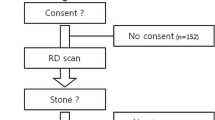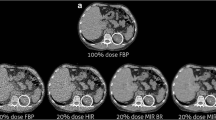Abstract
Purpose
To assess the effectiveness of reduced-radiation-dose computed tomography (CT) protocols in the tracing of the ureter in patients with suspected renal colic.
Methods
The study was approved by our institutional review board, and informed consent was obtained from the participants. From July 2012 to April 2014, 310 consecutive patients with suspected urolithiasis were recruited to undergo unenhanced CT at 280 (n = 62), 200 (n = 62), 140 (n = 62), 100 (n = 62), and 70 (n = 62) reference mA seconds (mAs) while keeping other imaging parameters constant. Images were independently and randomly reviewed by two radiologists blinded to the study to determine the tracing rates of the ureter and the acceptable rates of image quality according to different tube charge settings.
Results
A significant linear association was noted between tube charge settings, the rates for tracing of the ureter, and the acceptability of image quality (linear-by-linear association; p = 0.000 in all rates for both readers). The 140 reference mAs is the point at which the tracing rates deteriorate rapidly, with the tracing rate of 41.5% (95% CI 32.6%–51.0%) in reader 1 and 51.9% (95% CI 42.5%–61.2%) in reader 2, and with the acceptable rate of 82.3% (95% CI 70.8%–90.0%) in reader 1 and 96.8% (95% CI 88.3%–99.8%) in reader 2.
Conclusion
Decreasing the tube charge settings from 280 to 70 reference mAs resulted in a significant reduction in the tracing rate of the ureter, with 140 reference mAs being the breaking point.





Similar content being viewed by others
References
Smith RC, Rosenfield AT, Choe KA, et al. (1995) Acute flank pain: comparison of non-contrast-enhanced CT and intravenous urography. Radiology 194(3):789–794. doi:10.1148/radiology.194.3.7862980
Kambadakone AR, Eisner BH, Catalano OA, Sahani DV (2010) New and evolving concepts in the imaging and management of urolithiasis: urologists’ perspective. Radiographics 30(3):603–623. doi:10.1148/rg.303095146
Smith RC, Coll DM (2000) Helical computed tomography in the diagnosis of ureteric colic. BJU Int 86(Suppl 1):33–41
Smith RC, Verga M, McCarthy S, Rosenfield AT (1996) Diagnosis of acute flank pain: value of unenhanced helical CT. AJR Am J Roentgenol 166(1):97–101. doi:10.2214/ajr.166.1.8571915
Cohnen M, Poll LJ, Puettmann C, et al. (2003) Effective doses in standard protocols for multi-slice CT scanning. Eur Radiol 13(5):1148–1153. doi:10.1007/s00330-002-1614-9
Mettler FA Jr, Huda W, Yoshizumi TT, Mahesh M (2008) Effective doses in radiology and diagnostic nuclear medicine: a catalog. Radiology 248(1):254–263. doi:10.1148/radiol.2481071451
Brenner DJ, Hall EJ (2007) Computed tomography—an increasing source of radiation exposure. N Engl J Med 357(22):2277–2284. doi:10.1056/NEJMra072149
Slovis TL (2002) CT and computed radiography: the pictures are great, but is the radiation dose greater than required? AJR Am J Roentgenol 179(1):39–41. doi:10.2214/ajr.179.1.1790039
Jin DH, Lamberton GR, Broome DR, et al. (2010) Effect of reduced radiation CT protocols on the detection of renal calculi. Radiology 255(1):100–107. doi:10.1148/radiol.09090583
Jellison FC, Smith JC, Heldt JP, et al. (2009) Effect of low dose radiation computerized tomography protocols on distal ureteral calculus detection. J Urol 182(6):2762–2767. doi:10.1016/j.juro.2009.08.042
Katz DS, Venkataramanan N, Napel S, Sommer FG (2003) Can low-dose unenhanced multidetector CT be used for routine evaluation of suspected renal colic? AJR Am J Roentgenol 180(2):313–315. doi:10.2214/ajr.180.2.1800313
Sottier D, Petit JM, Guiu S, et al. (2013) Quantification of the visceral and subcutaneous fat by computed tomography: interobserver correlation of a single slice technique. Diagn Interv Imaging 94(9):879–884. doi:10.1016/j.diii.2013.04.006
Katz SI, Saluja S, Brink JA, Forman HP (2006) Radiation dose associated with unenhanced CT for suspected renal colic: impact of repetitive studies. AJR Am J Roentgenol 186(4):1120–1124. doi:10.2214/AJR.04.1838
Hinkley DV (1970) Inference about change-point in a sequence of random variables. Biometrika 57(1):1–17
Killick R, Fearnhead P, Eckley IA (2012) Optimal detection of changepoints with a linear computational cost. J Am Stat Assoc 107(500):1590–1598. doi:10.1080/01621459.2012.737745
Killick R, Eckley IA (2014) changepoint: an R package for changepoint analysis. J Stat Softw 58(3):1–19
McCollough CH, Primak AN, Braun N, et al. (2009) Strategies for reducing radiation dose in CT. Radiol Clin North Am 47(1):27–40. doi:10.1016/j.rcl.2008.10.006
Ekstrom MP (2012) Digital image processing techniques, vol. 2. Cambridge: Academic Press
Singh S, Kalra MK, Hsieh J, et al. (2010) Abdominal CT: comparison of adaptive statistical iterative and filtered back projection reconstruction techniques. Radiology 257(2):373–383. doi:10.1148/radiol.10092212
Padole A, Ali Khawaja RD, Kalra MK, Singh S (2015) CT radiation dose and iterative reconstruction techniques. AJR Am J Roentgenol 204(4):W384–W392. doi:10.2214/AJR.14.13241
Wall BF, Hart D (1997) Revised radiation doses for typical X-ray examinations. Report on a recent review of doses to patients from medical X-ray examinations in the UK by NRPB. National Radiological Protection Board. Br J Radiol 70(833):437–439. doi:10.1259/bjr.70.833.9227222
Author information
Authors and Affiliations
Corresponding author
Ethics declarations
Funding
This study was funded by a clinical research grant-in-aid from the Seoul Metropolitan Government Seoul National University (SMG-SNU) Boramae Medical Center (03-2013-10).
Conflict of interest
The authors declare that they have no conflict of interest.
Ethical approval
All procedures performed in studies involving human participants were in accordance with the ethical standards of the institutional and/or national research committee and with the 1964 Helsinki declaration and its later amendments or comparable ethical standards.
Informed consent
Informed consent was obtained from all individual participants included in the study.
Rights and permissions
About this article
Cite this article
Sung, C.K., Moon, M.H., Son, H. et al. Standard vs. reduced-radiation-dose CT in the tracing of the ureter. Abdom Radiol 42, 900–907 (2017). https://doi.org/10.1007/s00261-016-0929-y
Published:
Issue Date:
DOI: https://doi.org/10.1007/s00261-016-0929-y




